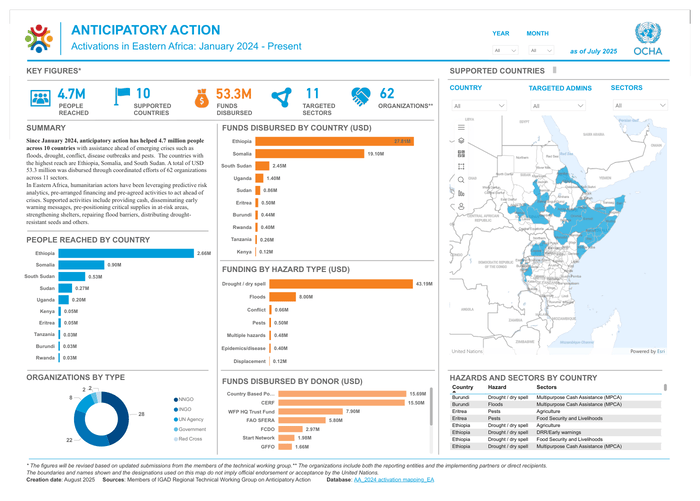Anticipatory Action in Eastern Africa: A Lifeline for Millions in 2024
Summary of Essential Humanitarian Efforts
Since January 2024, anticipatory action has emerged as a pivotal strategy to assist 4.7 million individuals across 10 countries in Eastern Africa. This proactive approach addresses potential crises, including floods, drought, conflict, disease outbreaks, and pests. The nations most significantly impacted include Ethiopia, Somalia, and South Sudan. Humanitarian efforts have mobilized a total of USD 53.3 million through the collaborative work of 62 organizations across 11 sectors.
Leveraging Predictive Risk Analytics
In Eastern Africa, humanitarian organizations are employing predictive risk analytics to mitigate the impending risks associated with climate change and socio-political instability. By utilizing data-driven insights, these organizations can implement pre-arranged financing and execute pre-agreed activities designed to address crises before they escalate.
Key Strategies Employed
The anticipatory actions have manifested in a variety of supportive measures:
- Cash Assistance: Direct financial support to vulnerable communities to bolster their resilience during emergencies.
- Early Warning Messaging: Dissemination of timely information to prepare communities for potential risks.
- Pre-positioning Supplies: Strategic placement of essential materials in high-risk areas to ensure rapid response during crises.
- Shelter Strengthening: Enhancing existing shelter infrastructures to withstand adverse weather conditions.
- Flood Barrier Repairs: Restoration of barriers to prevent flooding and protect local populations.
- Drought-resistant Seeds Distribution: Providing farmers with seeds that can withstand long periods of drought, ensuring food security.
Impact and Reach
The immediate need for such interventions is underscored by the scale of assistance provided across Eastern Africa. By acting ahead of crises, humanitarian actors have ensured that millions can access life-saving resources, thereby reducing potential harm and loss of life.
To delve deeper into the ongoing initiatives, you can explore the Eastern Africa AA Activations 2024-2025 Interactive Dashboard which provides further insights into the geographic distribution and specifics of these humanitarian efforts.
Conclusion
The strategies employed by humanitarian organizations in Eastern Africa represent a model of efficiency and proactivity in dealing with crises. By prioritizing anticipatory action, they are not only responding to immediate needs but also fostering long-term resilience within vulnerable communities. For further information on humanitarian activities and strategies, visit the UN Office for the Coordination of Humanitarian Affairs.
This article is structured to ensure clarity and engagement while optimizing for SEO with relevant links and terms. Each aspect of the humanitarian efforts highlights the importance of anticipatory actions in Eastern Africa, making the information easily accessible and understandable.
